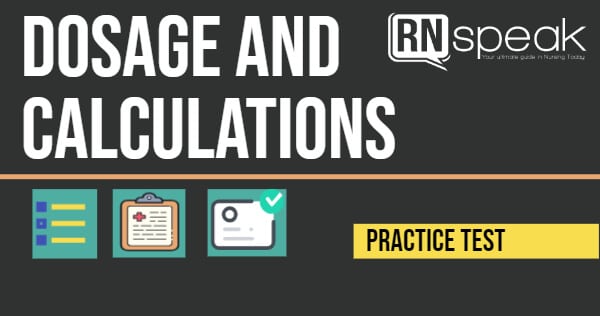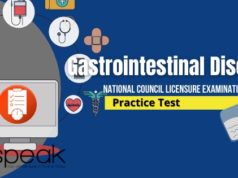Dosage and Calculations Practice Tests are some of the most commonly-searched practice exams for both student nurses and nurses wanting to take licensure and certification exams.
This is because when such items are asked in examinations, an examinee is expected to calculate and compute drug dosages for their patients. It is expected that these computations are accurate. Moreover, apart from the need to compute the desired dosages, there is also the time limit that the tests are bound by and the need to memorize the formula to solve these problems.
While there is no foolproof method for memorizing this formula and ensuring that the correct answer to these questions is provided at all times, preparation is always one of the best strategies for acing any test.
The following questions are intended to help you practice calculating dosages for adult and pediatric patients, as well as compute IV infusion rates. A bonus section contains information on the most frequently asked therapeutic levels of medications.
Dosage and Calculations Practice Test
1. The nurse is administering mannitol to the client with a head injury. The order reads 1,000 mL IVPB over 6 hours. At which rate should the nurse administer the medication via a pump?
Answer: _______ mL per hour.
2. The client diagnosed with bacterial endocarditis is prescribed gentamicin IV piggyback (IVPB). The IVPB comes in 100 mL of fluid to be administered over 1 hour on an IV pump. At what rate should the nurse administer the medication?
Answer: _______ mL.
3. A health care provider’s prescription reads 1000 mL of normal saline (NS) to infuse over 12 hours. The drop factor is 15 drops (gtt)/1 mL. The nurse prepares to set the flow rate at how many drops per minute? Fill in the blank. Record your answer to the nearest whole number.
Answer: _______ drops per minute.
4. A health care provider prescribes 1000 mL D5W to infuse at a rate of 125 mL/hour. The nurse determines that it will take how many hours for 1 L to infuse? Fill in the blank.
Answer: _______ hour(s)
5. A health care provider prescribes heparin sodium, 1300 units/hour by continuous intravenous (IV) infusion. The pharmacy prepares the medication and delivers an IV bag 20,000 units/250 mLD5W. An infusion pump must be used to administer the medication. The nurse sets the infusion pump at how many milliliters per hour to deliver 1300 units/hour? Fill in the blank. Record the answer to the nearest whole number.
Answer: _______ mL per hour
6. A health care provider’s prescription reads morphine sulfate, 8 mg stat. The medication ampule reads morphine sulfate, 10 mg/mL. The nurse prepares how many milliliters to administer the correct dose? Fill in the blank.
Answer: _______ mL
7. A health care provider prescribes regular insulin, 8 units/hour by continuous intravenous (IV) infusion. The pharmacy prepares the medication and then delivers an IV bag labeled 100 units of regular insulin in 100 mL normal saline (NS). An infusion pump must be used to administer the medication. The nurse sets the infusion pump at how many milliliters per hour to deliver 8 units/hour? Fill in the blank.
Answer: _______ mL/hour
8. A child weighs 11.2 kg and has an order for Acyclovir 120 mg IV every 8 hours. The safe dose range (SDR) of Acyclovir is 25-50 mg/kg/day. What is the SDR in mg for this child in 24 hours? Round to nearest tenth.
9. A child weighs 11.2 kg and has an order for Acyclovir 120 mg IV every 8 hours. The safe dose range (SDR) of Acyclovir is 25-50 mg/kg/day. What is the divided dose range in mg for this child? Round to nearest tenth.
10. A pediatric patient is prescribed to receive 5 mg/kg/day of a medication, divided in two equal doses. If the child weighs 48 pounds, how much medication is the nurse supposed to administer?
a. 54 mg
b. 80 mg
c. 55 mg
d. 78 mg
11. A laboring client with preeclampsia is prescribed magnesium sulfate 2 g/hour I.V. piggyback the pharmacy sends the I.V. to the unit labeled magnesium sulfate 20 g/500 mL normal saline. To deliver the correct dose, the nurse should set the pump to deliver how many milliliters per hour?
Answer: __________________ mL.
12. A client at 28 weeks’ gestation in premature labor was placed on ritodrine (Yutopar). To maintain the pregnancy, the physician orders the client to have 10 mg now, 10 mg in 2 hours, and then 20 mg every 4 hours while contractions persist, not to exceed the maximum daily oral dose of 120 mg. At what time will the client have reached the maximum dose if she begins taking the medication at 10:00 a.m. and follows the physician’s order?
Answer: ____________________ a.m.
13. The physician orders ampicillin 100 mg/kg/ dose for a newly admitted neonate. The neonate weighs 1,350 g. How many milligrams should the nurse administer?
Answer: _____________________ mg.
14. Commercial formulas contain 20 calories per ounce. A 1-day-old infant’s weight in the morning was 8 lb and he was fed 45 mL at 2 a.m., 5:30 a.m., 8 a.m., 11 a.m., 2 p.m., 4:30 p.m., 8 p.m., and 10:30 p.m. What is the total amount of calories the infant received today?
Answer: _________________ calories.
15. A newborn weighing 6½ lb is to be given naloxone hydrochloride (Narcan) due to respiratory depression as a result of a narcotic given to the mother shortly before delivery. The drug is to be given 0.01 mg/kg into the umbilical vein. The vial is marked 0.4 mg/mL. How many milligrams would the newborn receive? Round to two decimals.
Answer: ______________________ mg.
16. A health care provider’s prescription reads “ampicillin sodium 125 mg IV every 6 hours.” The medication label reads “when reconstituted with 7.4 mL of bacteriostatic water, the final concentration is 1 g/7.4 mL.” The nurse prepares to draw up how many milliliters to administer 1 dose?
a. 1.1 mL
b. 0.54 mL
c. 7.425 mL
d. 0.925 mL
17. A pediatric client with ventricular septal defect repair is placed on a maintenance dosage of digoxin. The dosage is 8 mcg/kg/day, and the client’s weight is 7.2 kg. The health care provider (HCP) prescribes the digoxin to be given twice daily. The nurse prepares how many mcg of digoxin to administer to the client at each dose?
a. 12.6 mcg
b. 21.4 mcg
c. 28.8 mcg
d. 32.2 mcg
18. Penicillin G procaine, 1,000,000 units IM (intramuscularly), is prescribed for a child with an infection. The medication label reads “1,200,000 units per 2 mL.” The nurse has determined that the dose prescribed is safe. The nurse administers how many milliliters per dose to the child?
a. 0.8 mL
b. 1.2 mL
c. 1.4 mL
d. 1.7 mL
19. Atropine sulfate, 0.6 mg intramuscularly, is prescribed for a child preoperatively. The nurse has determined that the dose prescribed is safe and prepares to administer how many milliliters to the child? Fill in the blank (refer to figure).
20. The child diagnosed with infectious gastroenteritis is prescribed trimethoprim sulfa 10 mg/kg/day in divided doses twice a day. The child weighs 60 pounds. The medication comes 100 mg/5 mL. How many milliliters will the nurse administer with the morning dose?
Answer: mL.
21. The HCP writes an order to decrease TPN rate by 5 mL every hour while discontinuing TPN. The current rate is 77 mL/hr. What rate should the nurse set 3 hours after transcribing the order?
Answer: mL.
22. The physician orders an intravenous infusion of 5% dextrose in 0.25 normal saline to be infused at 2 mL/kg/hour in an infant who weighs 9 lb. How many milliliters per hour of the solution should the nurse infuse? Round to one decimal place.
Answer_________________ mL/hour.
23. A child with nephrosis is placed on prednisone. The dose is 2 mg/kg/day to be administered twice a day. The child weighs 25 lb. How many milligrams will the child receive at each dose?
Answer: __________________ mg.
24. A client with hypertensive emergency is being treated with sodium nitroprusside (Nipride). In a dilution of 50 mg/250 mL, how many micrograms of Nipride are in each milliliter?
Answer: ___________________ mcg.
25. A client who weighs 187 lb has an order to receive enoxaparin (Lovenox) 1 mg/kg. This drug is available in a concentration of 30 mg/0.3 mL. What dose would the nurse administer in milliliters?
Answer: __________________ mL.
26. The 19-year-old client diagnosed with a severe herpes simplex 2 viral infection is admitted to the medical floor. The HCP prescribes acyclovir 10 mg/kg IVPB every 8 hours. The client weighs 220 pounds. How many milligrams will the nurse administer with each dose?
Answer: ___________________ mg.
27. Guaifenesin (Robitussin) 300 mg four times a day has been ordered as an expectorant. The dosage strength of the liquid is 200 mg/5 mL. How many milliliters should the nurse administer for each dose?
Answer: __________________ mL.
28. A nurse is to administer 10 mg of morphine sulfate to a client with three fractured ribs. The available concentration for this drug is 15 mg/mL. How many milliliters should the nurse administer? Round to one decimal point.
Answer: __________________ mL.
29. A client who is recovering from gastric surgery is receiving I.V. fl uids to be infused at 100 mL/hour. The I.V. tubing delivers 15 gtt/mL. The nurse should infuse the solution at a flow rate of how many drops per minute to ensure that the client receives 100 mL/hour?
Answer: ____________________ gtt/minute.
30. The nurse has an order to administer sulfasalazine (Azulfidine) 2 g. The medication is available in 500-mg tablets. How many tablets should the nurse administer?
Answer: _________________ tablets.










Number 23 is wrong, if you are rounding to one decimal place.
Very helpful article love it.
Yes, love this concern good article
i concur with you